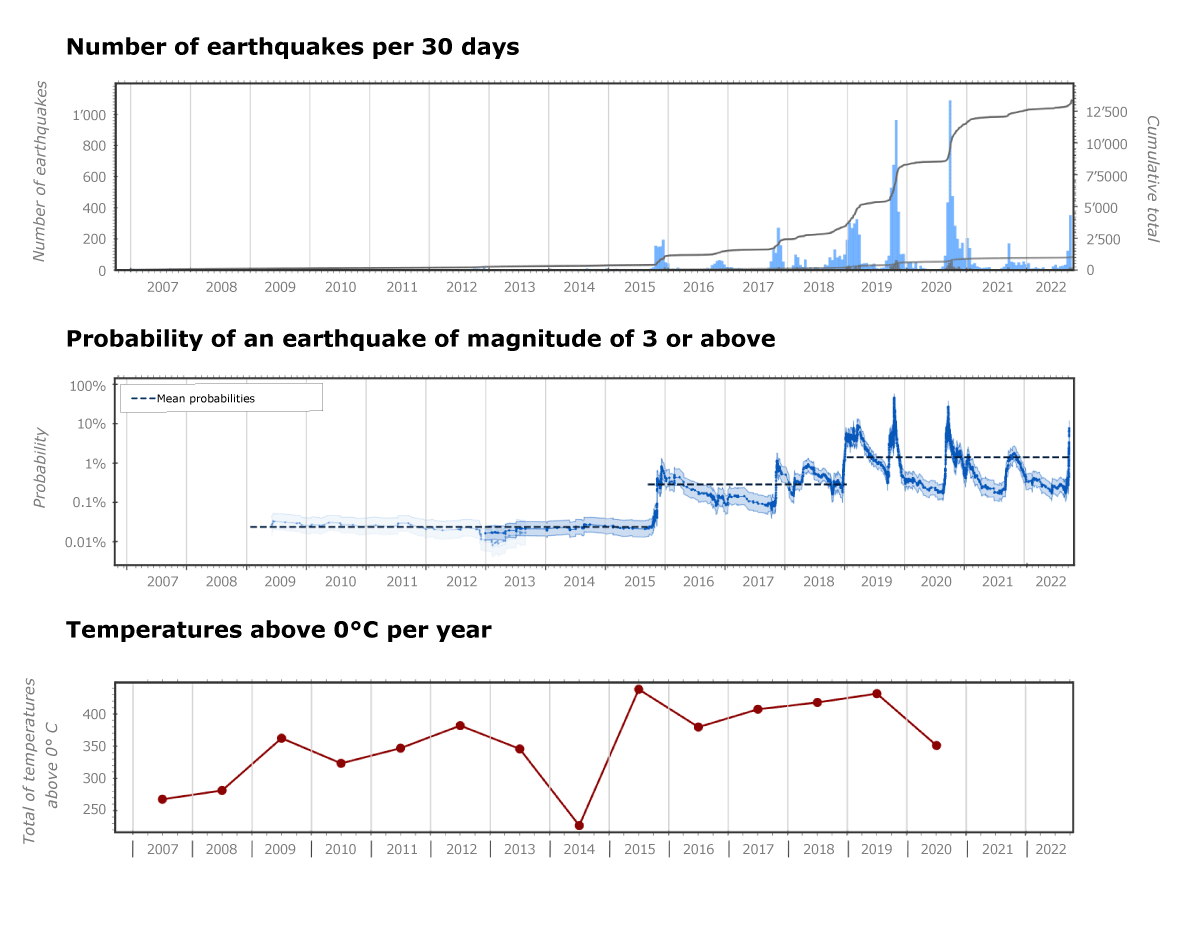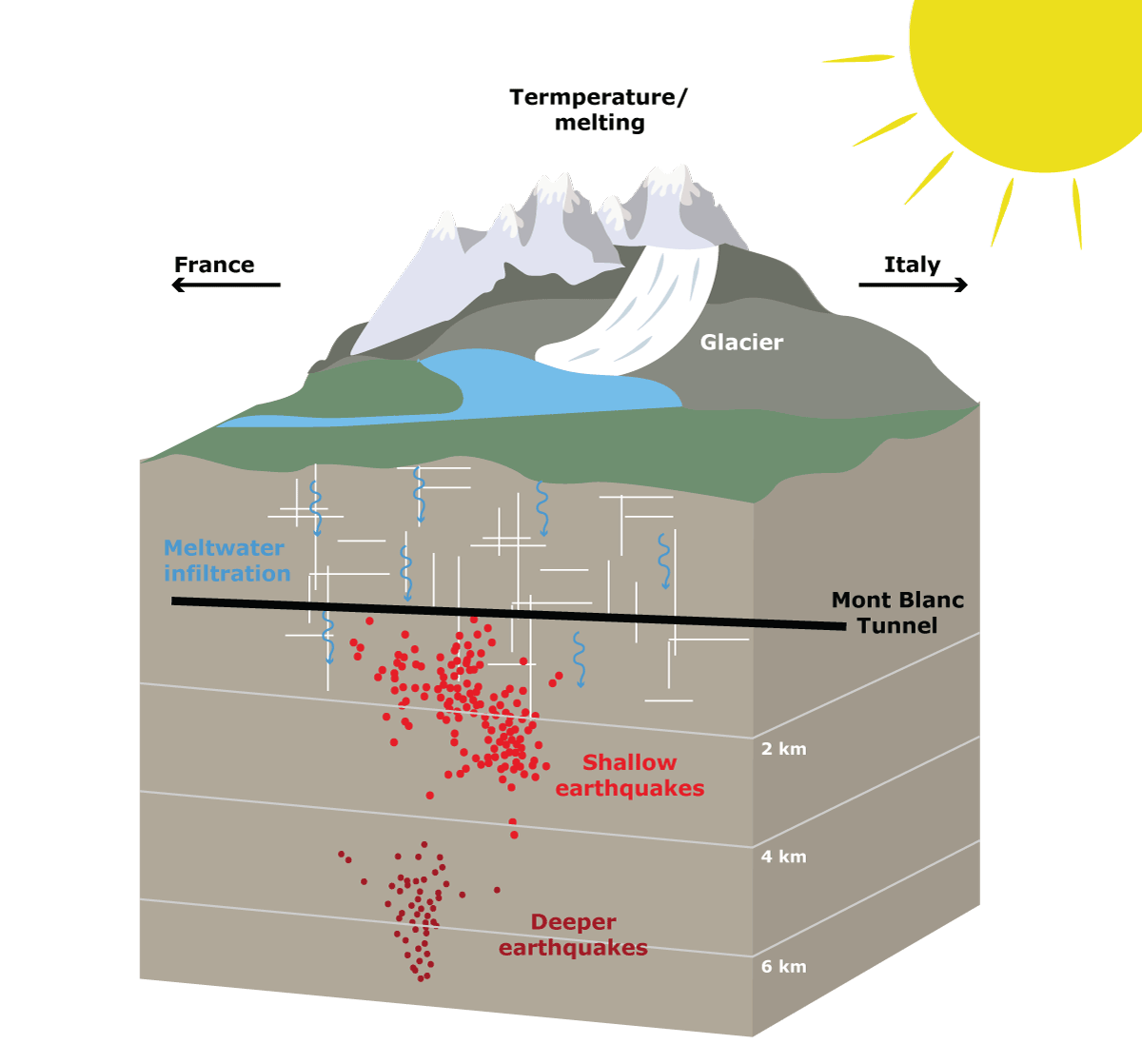2025-07-02
Glacier melt increases seismic activity under the Mont Blanc Massif
There have been repeated small earthquakes under and around the Mont Blanc Massif for around ten years now. A new study demonstrates for the first time a link between climate-driven changes in glaciated high mountain regions and increased local earthquake hazard. The findings by researchers from the Swiss Seismological Service (SED) at ETH Zurich, the BRGM (Bureau de Recherches Géologiques et Minières), or French geological survey, in Montpellier and ISTerre (Institut des Sciences de la Terre/Institute of Earth Sciences) in Grenoble are of importance for the prevention of natural hazards in high alpine and arctic regions around the world.
The Mont Blanc Massif, at the intersection between France, Italy and Switzerland, encompasses Mont Blanc and ten other peaks over 4,000 metres, including the Grandes Jorasses. Previously, only isolated earthquakes had been recorded beneath the Grandes Jorasses. However, a distinct and persistent earthquake sequence has been active there since autumn 2015. What is striking about these earthquakes is that they follow a clear seasonal pattern and are particularly frequent in autumn.
The study attributes the rise in seismic activity to the increasing impact of climate change in high mountain regions. Heatwaves in these regions are causing permafrost to thaw and are accelerating glacier melt. As a result, rockfalls are increasing. This is altering meltwater infiltration pathways, thus affecting the pore water pressure all the way down to deep rock formations and changing the stress regime in the underground. These processes are reflected in increased seismic activity in regions where no earthquakes had previously been observed.
The power of meltwater
Underneath the Mont Blanc Massif and the Grandes Jorasses is a water-permeable weak zone in the rock that is up to 600 metres wide. This facilitates meltwater infiltration. The study found that, along this tectonically weakened zone, young, cold meltwater from glaciers located some 2,500 metres higher up penetrates into the Mont Blanc Tunnel after around 70 days. The earthquakes are concentrated along the weak zone at depths of up to eight kilometres below the level of the tunnel. The researchers' modelling revealed that the penetrating meltwater increases the pore water pressure there after a period varying between several months and a number of years and can intensify seismic activity. The pore water pressure weakens the stabilising rock stress that acts perpendicularly on the rock surfaces. This allows shear stresses acting parallel to these surfaces to be released more easily, which manifests itself in the form of earthquakes.
Increase in local earthquake hazard
The research team used modern techniques to record and analyse more than 12,000 microearthquakes that occurred below the Grandes Jorasses between 2006 and 2022. The analyses revealed that the earthquake hazard has increased tenfold since 2015 compared to previous years. Even more striking is the increase in short-term earthquake hazard during the colder months from autumn to spring, which has risen by a factor up to 10,000. This refers to the probability of an earthquake of a certain magnitude occurring within a short period of time. The study examined the likelihood of an earthquake of magnitude 3 or greater occurring within the next 24 hours. During the colder season – that is, during periods of increased seismic activity – this probability can exceed 10 %. This means that, on average, an earthquake of this magnitude could be expected every ten days. It was during such a high-activity phase in March 2019 that the strongest earthquake in the sequence occurred, with a magnitude of 3.1, supporting the study’s findings.
However, the study can only reliably represent the relative change in earthquake hazard. Further investigations would be required in order to determine robust absolute values.

Since 2015, there has been a significant rise in temperatures above freezing. This has coincided with a significant increase in seismic activity – and with it the local seismic hazard, especially in the months from autumn to spring.
Ensuring improved earthquake preparedness
Seasonal fluctuations in seismic activity due to changes in pore water pressure have already been observed in other parts of the world. However, this study provides evidence for the first time that this phenomenon, which is made more likely by climate change, can lead to a significantly higher local seismic hazard.
This is a key finding with a view to ensuring improved earthquake preparedness in alpine regions, which may be increasingly exposed to earthquakes in the future as a result of climate change. This is relevant not only to the Mont Blanc Massif but also to other high alpine or arctic regions around the world.
Link to the study
Simon, V., Kraft, T., Maréchal, J.-C., Helmstetter, A., & Diehl, T. (2025). Climate-change-induced seismicity: The recent onset of seasonal microseismicity at the Grandes Jorasses, Mont Blanc Massif, France/Italy. Earth and Planetary Science Letters, 666, 119372. https://doi.org/10.1016/j.epsl.2025.119372
News article in Science
https://www.science.org/content/article/global-warming-triggering-earthquakes-alps
